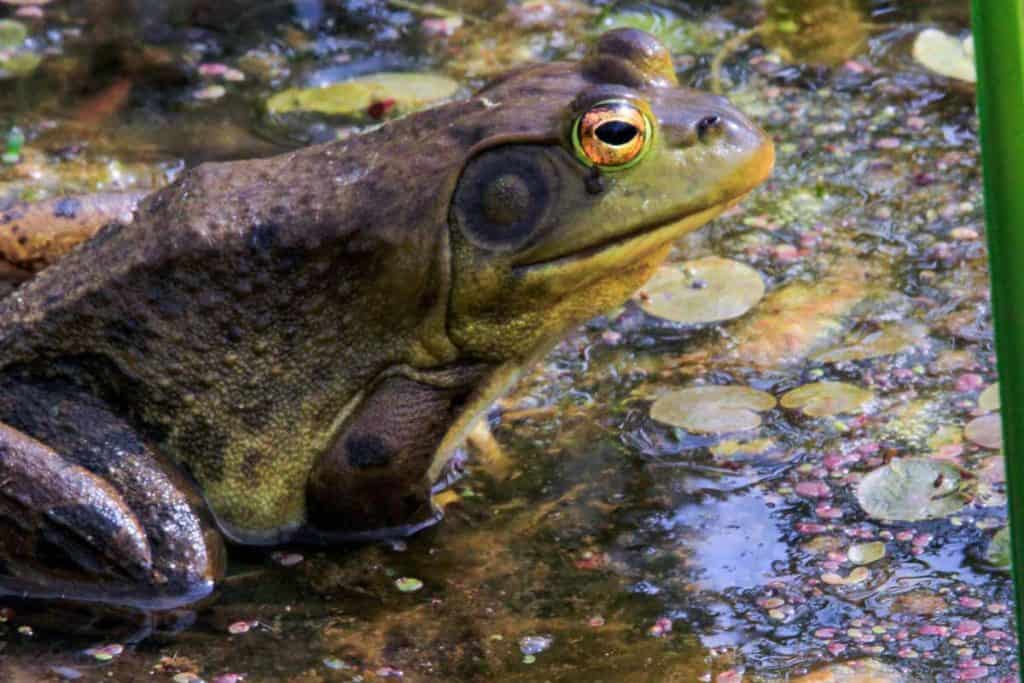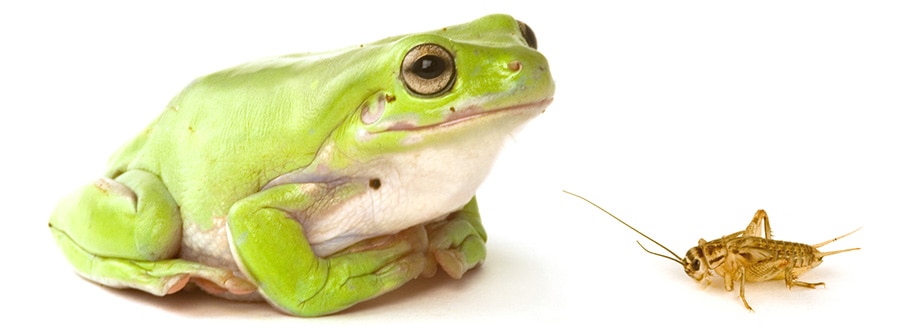Frogs may be one of the most common amphibians, but they are incredibly interesting. And since they are not too popular in the pet trade, most people do not know much about them, much less take care of them and what to feed them.
Read on to find out what to feed your frogs, how often they should be fed, and what time of the day is the best to feed them!
Frogs are carnivores. This means they only eat animal-based protein. This can sound like a pretty restrictive diet, but it is not! Frogs can eat a wide variety of foods and are only limited by the size of their mouths!
Frogs can eat worms, insects, snails, slugs, mollusks, crustaceans, feeder fish, and small mammals such as pinky mice and even rats! Variety is the spice of life, and that could not be truer for frogs. Ideally, your frog should have a varied diet to keep their interest in their food and to stimulate them mentally.
What Do Frogs Eat?
Frogs eat a variety of foods, and it is important to know which foods are more nutritionally beneficial as staple items and which should be used as treat items. Many foods frogs can eat may be tasty but are not the healthiest options.
Note: A tadpole, a.k.a. a baby frog, has a vastly different diet from an adult frog. Learn all about feeding a tadpole here.
Staple Food Items
Nightcrawlers (also known as large earthworms) are excellent items to feed frogs. They are full of protein and other nutrients that are vital for your frog’s survival. Nightcrawlers can be very large, so you will need to chop them up for small frogs. Nightcrawlers are also easy to farm yourself!
Crickets will form the basis of most terrestrial frogs’ diets because they are the most accessible staple feeder insects and they are very nutritious. Crickets are very high in protein and will prompt a strong hunting response from your frog. Crickets are also fairly easy to farm yourself!
Other similar insects like grasshoppers and locusts provide exceptional variety to your frog’s diet. However, these are usually reserved for larger frogs due to the insects’ larger size. Locusts and grasshoppers are also a bit more difficult to find at pet stores and to farm at home yourself.
Bloodworms, blackworms, and tubifex are all excellent options for aquatic frogs. They are bright red and attract the frogs to them. This is helpful when feeding young frogs because these bright red worms prompt a serious feeding response.
Brine shrimp are packed with nutrients and can feature as often as you would like in your aquatic frog’s diet. Brine shrimp can only survive for half an hour in fresh water, so make sure you do not add too many into the enclosure at a time, as they will die and start raising the ammonia levels in the tank.
Some frogs are large enough that they can eat mouse pinkies, full-grown mice, and even rat fuzzies! Pixie frogs (also known as African bullfrogs) and Pacman frogs have mouths that are large enough and jaws that are strong enough to easily eat these small mammals!
Certain fish are perfect regular snacks for aquatic frogs. Guppies, minnows, and rosy reds are all great options. These fish need to be captive-bred specifically to be eaten to ensure they are free from parasites.
Snails and slugs are tasty treats as well as being very healthy for most frogs! They are packed with protein.
Treat Food Items
Waxworms and butter worms are very tasty and frogs generally love them. However, they are incredibly high in fat. This means they should not feature in every one of your frog’s meals. They should mainly be used as a treat item.
Mealworms are extra crunchy and tasty! However, they are also high in fat and low in hydration. Therefore, they should be used only as treats or at least in addition to other food items.
What Not to Feed Your Frog
Although frogs can eat a wide range of different insects, fish, and invertebrates, there are also lots of foods they can’t eat, either because they are toxic, indigestible, or nutritionally poor.
Insects That Glow
All insects that glow or are bioluminescent are toxic and should not be eaten at all. Fireflies, lightning bugs, and any shrimp that glow should never be fed to your frog.
Fruits and Vegetables
As stated earlier, frogs are carnivores. This means they should only ever eat meat. A frog’s digestive system is not suited to plant matter. Eating any kind of plant matter will make your frog very sick.
Human Food
Most foods that are safe for humans contain various chemicals and additives that are toxic to frogs. It is essential that they are not fed human food, as it will damage their digestive system, make them ill, and possibly cause their death.
Anything From Your Garden or Wild-Sourced
Insects, snails, and slugs from your garden can carry dangerous parasites that can be transferred to your frog and its enclosure. Always make sure your frog’s food items come from a reputable source or you have farmed them yourself.
When to Feed Your Frog
When you feed your frog will depend on whether they are a diurnal or nocturnal species. Research your frog’s species and find out when they are the most active, either during the day (diurnal) or at night (nocturnal).
If your frog is nocturnal, then you should feed them in the evening or at night. This will ensure they start digesting the food when they are most active.
If your frog is diurnal, then you should feed them in the morning or at midday. This will ensure they have time to digest their food before they stop moving around for the night.
Stick to the same time of the day when feeding your frog. A consistent diet will help them get accustomed to a schedule that will build a routine for them.
How Often to Feed Your Frog
How often you should feed your frogs will depend on their species and size. Small and high-energy frogs should generally be fed once a day. Medium-sized frogs should usually need to be fed every second day or third day, and larger frogs that are very low-energy and slow-moving typically only need to be fed once to twice a week.
Stick to a regular schedule to encourage them to eat. If the food is predictable, then your frog is more likely to eat its food consistently.
When feeding your frog, you should let them eat as many food items as they will eat in 15 minutes. Make sure you remove uneaten food items from the enclosure. If you leave insects in the enclosure, they can cause physical harm as well as stress your frog out. If you leave uneaten items in an aquatic tank, they will decompose and raise the ammonia levels in the water.
If you want information on the care of specific frog species, check out our guides on looking after red-eyed tree frogs and White’s tree frogs.
FAQs About What Frogs Eat
Do frogs need supplements?
Yes! Most frogs need a
Dust your frog’s food in
How can I take care of the frogs in my garden?
If you are lucky enough to have frogs in your garden, then you can encourage them to stay by feeding them! Frogs will act as natural pest controllers and eat any snails, slugs, and caterpillars that may be plaguing your garden.
However, you cannot simply feed them anything.
Stick to what you would feed a captive frog. You can even dust the insects and worms you feed them with
calcium powder to ensure you have a strong, healthy population of frogs.
If you wish to keep the frogs alive long-term, you will need to make sure you do not use pesticides, insecticides, herbicides, slug pellets, or ant poison in your garden. The insects or slugs that eat the poisoned items will pass on that poison to the frog and kill them.
You can also put little hides in the garden during winter to help them stay warm.
Frogs encourage natural biodiversity in your garden and will help your plants flourish.
Hopping Off…
So to conclude… what do frogs eat? Almost anything that wiggles, flies, or swims! Frogs have voracious appetites, and most species will eat almost anything you put in front of them. The key is to feed them a variety of nutritious and delicious food items.
Variety (in food items) and consistency (in regular feedings) are keys to keeping your frog’s interest in their food and ensuring their nutritional needs are being taken care of.
Feeding your frog should be a fun experience both for your frog and for you! It gives you time to observe their natural hunting behavior and allows you to bond with them.





